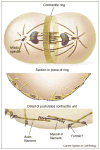Mechanics of cytokinesis in eukaryotes
- PMID: 20031383
- PMCID: PMC2871152
- DOI: 10.1016/j.ceb.2009.11.010
Mechanics of cytokinesis in eukaryotes
Abstract
Research on eukaryotic cytokinesis using advantageous model systems is rapidly advancing our understanding of most aspects of the process. Cytokinesis is very complicated with more than 100 proteins participating. Both fungi and animal cells use proteins to mark the cleavage site for the assembly of a contractile ring of actin filaments and myosin-II. Formins nucleate and elongate the actin filaments and myosin-II helps to organize the filaments into a contractile ring. Much is still to be learned about the organization of the contractile ring and the mechanisms that disassemble the ring as it constricts. Although fungi and animals share many proteins that contribute to cytokinesis, the extent to which they share mechanisms for the location, assembly, constriction, and disassembly of their contractile rings is still in question.
Copyright 2009 Elsevier Ltd. All rights reserved.
Figures


References
-
- Eggert US, Mitchison TJ, Field CM. Animal cytokinesis: from parts list to mechanisms. Annu Rev Biochem. 2006;75:543–566. - PubMed
-
- Barr FA, Gruneberg U. Cytokinesis: placing and making the final cut. Cell. 2007;131:847–860. - PubMed
-
- Oliferenko S, Chew TG, Balasubramanian MK. Positioning cytokinesis. Genes Dev. 2009;23:660–674. - PubMed
-
- Montagnac G, Echard A, Chavrier P. Endocytic traffic in animal cell cytokinesis. Curr Opin Cell Biol. 2008;20:454–461. - PubMed
Publication types
MeSH terms
Substances
Grants and funding
LinkOut - more resources
Full Text Sources
Molecular Biology Databases

